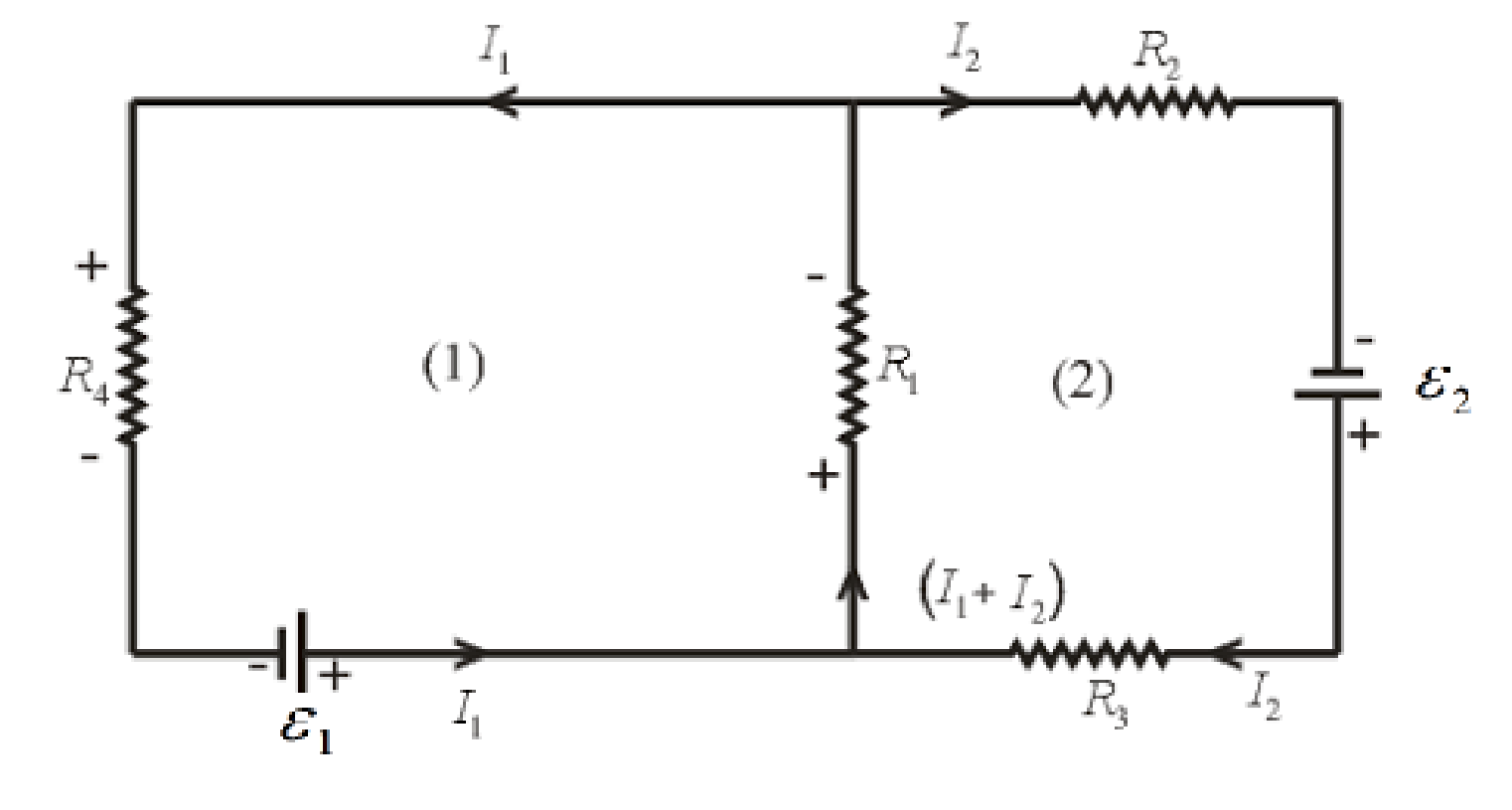
(a)
The power absorbed by each resistor when switch is open.
(a)
Answer to Problem 44PQ
The power absorbed by resistor
Explanation of Solution
When switch is open, battery
Write the expression for total current passes through the loop 2 as.
Here,
Write the expression for equivalent resistance of the loop 2 as.
Here,
Write the expression for the power-absorbed in resistor as.
Here,
Substitute
Here,
Substitute
Here,
Substitute
Here,
Substitute
Here,
Conclusion:
Substitute
Substitute
Substitute
Substitute
Substitute
Substitute
Thus, the power absorbed by resistor
(b)
The power absorbed by each resistor when switch is closed.
(b)
Answer to Problem 44PQ
When switch is closed, the power absorbed by resistor
Explanation of Solution
When switch is closed, battery

Refer to above figure, apply Kirchhoff’s voltage law in the first loop.
Write the expression for current as.
Simplify the above equation as.
Here,
Refer to above figure, apply Kirchhoff’s voltage law in the loop 2.
Write the expression for current as.
Simplify the above equation as.
Here,
Write the expression for power absorbed by resistor
Here,
Write the expression for power absorbed in resistor
Here,
Write the expression for power absorbed by resistor
Here,
Write the expression for power absorbed by resistor
Here,
Conclusion:
Substitute
Rearrange the above equation as.
Substitute
Rearrange the above equation as.
Simplify and solve equation (XIII) and equation (XIV) as.
The current in the loop 2 is given as.
Substitute
Substitute
Substitute
Substitute
Thus, when switch is closed, the power absorbed by resistor
Want to see more full solutions like this?
Chapter 29 Solutions
EBK WEBASSIGN FOR KATZ'S PHYSICS FOR SC
- 1. What is the spring constant of a spring that starts 10.0 cm long and extends to 11.4 cm with a 300 g mass hanging from it?arrow_forwardplease help me solve all parts of this question from physics. thanks so much in advance! :)))arrow_forwardA fluid with density 263 kg/m3 flows through a pipe of varying diameter and height. At location 1 the flow speed is 13.5 m/s and the diameter of the pipe is 7.4 cm down to location 2 the pipe diameter is 16.9 cm. Location 1 is 6.3 meters higher than location 2. What is the difference in pressure P2 - P1? Using units in Pascals and use g = 9.81 m/s2.arrow_forward
- The kitchen had a temperature 46 degrees Fahrenheit and was converted it to Kelvin. What is the correct number for this temperature (46 F) on the Kelvin scale?arrow_forwardWater is traveling at a speed of 0.65 m/s through a pipe with a cross-section radius of 0.23 meters. The water enters a section of pipe that has a smaller radius, only 0.11 meters. What is the speed of the water traveling in this narrower section of pipe?arrow_forwardA particular water pipe has a radius of 0.28 meters. If the pipe is completely filled with water, moving with average velocity 0.45 m/s, what is the flow rate of water through the pipe with units of cubic meters of water per second?arrow_forward
- Water is flowing through a horizontal pipe with two segments. In one segment, the water flows at a speed v1 = 4.52 m/s. In the second segment the speed of the water is v2 = 2.38 m/s. Based on Bernoulli's Principle, what is the difference in pressure (P2 - P1) between the two segments? Assume that the density of the water is 997 kg/m3 and give your answer as the number of Pascals (i.e. N/m2).arrow_forwardWater from the faucet is supplied to the hose at a rate of 0.00057 m3/s. At what speed (number of meters per second) does the water exit the nozzle if the cross sectional area of the narrow nozzle is 2.1 x 10-6 m2?arrow_forwardJason Fruits/Indiana University Research Communications Silver/ silver oxide Zinc zinc/oxidearrow_forward
 Physics for Scientists and Engineers: Foundations...PhysicsISBN:9781133939146Author:Katz, Debora M.Publisher:Cengage Learning
Physics for Scientists and Engineers: Foundations...PhysicsISBN:9781133939146Author:Katz, Debora M.Publisher:Cengage Learning Principles of Physics: A Calculus-Based TextPhysicsISBN:9781133104261Author:Raymond A. Serway, John W. JewettPublisher:Cengage Learning
Principles of Physics: A Calculus-Based TextPhysicsISBN:9781133104261Author:Raymond A. Serway, John W. JewettPublisher:Cengage Learning Physics for Scientists and Engineers with Modern ...PhysicsISBN:9781337553292Author:Raymond A. Serway, John W. JewettPublisher:Cengage Learning
Physics for Scientists and Engineers with Modern ...PhysicsISBN:9781337553292Author:Raymond A. Serway, John W. JewettPublisher:Cengage Learning College PhysicsPhysicsISBN:9781938168000Author:Paul Peter Urone, Roger HinrichsPublisher:OpenStax College
College PhysicsPhysicsISBN:9781938168000Author:Paul Peter Urone, Roger HinrichsPublisher:OpenStax College Physics for Scientists and EngineersPhysicsISBN:9781337553278Author:Raymond A. Serway, John W. JewettPublisher:Cengage Learning
Physics for Scientists and EngineersPhysicsISBN:9781337553278Author:Raymond A. Serway, John W. JewettPublisher:Cengage Learning





